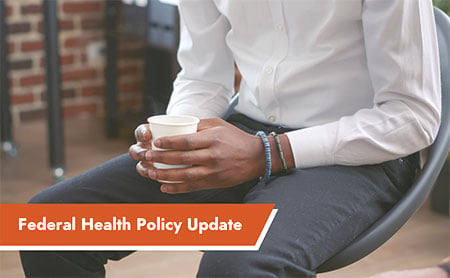The Fentanyl Crisis Requires Ongoing and Strategic Federal Action
February 19, 2024 | Catherine Jones
 Synthetic opioids, such as fentanyl, are now the most common drugs involved in drug overdose deaths in the United States. More than two thirds (68%) of the reported 107,081 drug overdose deaths in 2022 involved illicitly manufactured fentanyl. Black Americans and young people are among the hardest hit. This devasting crisis is profoundly complex, and the past year has spurred on congressional hearings, proposed legislation, and federal actions related to fentanyl.
Synthetic opioids, such as fentanyl, are now the most common drugs involved in drug overdose deaths in the United States. More than two thirds (68%) of the reported 107,081 drug overdose deaths in 2022 involved illicitly manufactured fentanyl. Black Americans and young people are among the hardest hit. This devasting crisis is profoundly complex, and the past year has spurred on congressional hearings, proposed legislation, and federal actions related to fentanyl.
There are life-saving measures that ASTHO members can continue to implement with ongoing support from Congress and federal agencies. These strategies include increasing access to naloxone, removing barriers to implementation of harm reduction strategies, such as drug checking and test strips, and supporting increased access to treatment and recovery services. HHS recently marked two years of advancements under the Biden-Harris Administration’s Overdose Prevention Strategy, which focuses on four key areas including primary prevention, harm reduction, evidence-based treatment, and recovery support.
The Overdose Prevention Strategy provides a roadmap for federal agencies to collaboratively address overdose, as well as a framework to guide state and local prevention efforts. The goal of saving lives from illicit fentanyl overdose is a shared mission for Congress, ASTHO and its members, and partner organizations that provide services for people struggling with drug addiction.
Federal Action on Prevention, Treatment, and Recovery
Advancements made by federal agencies under the Overdose Prevention Strategy include the establishment of permanent flexibilities for opioid treatment programs (OTPs) that began during the COVID-19 pandemic, new opportunities to leverage federal grant funding for the purchase of test strips, and new resources for the overdose prevention workforce. The Biden-Harris Administration also recently took steps to expand access to overdose reversal medications such as naloxone. These measures include new guidelines for the inclusion of overdose reversal medications in safety stations in all federal facilities, and calls to action for schools and housing authorities to ensure that overdose reversal medications are available to those who are vulnerable to overdose. The White House requested $1.55 billion to expand treatment for addiction and harm reduction programs under State Opioid Response grants.
In December 2023, the House passed the Support for Patients and Communities Reauthorization Act (H.R. 4351), also known as the SUPPORT Act. If enacted into law, this bill would reauthorize and modify various grants, programs, and activities through FY28 that address: (1) substance use and misuse including data collection, education, and surveillance, (2) grants and other support for substance use disorder (SUD) prevention, treatment, and recovery, (3) student loan repayment and programs for the SUD workforce, and (4) programs for addressing trauma, particularly for children, youth, and their families. The bill would make permanent a requirement that Medicaid programs cover medication-assisted treatment for individuals with SUD.
At this critical time, these federal actions help to improve access to medications for opioid use disorder and drug checking test strips, and they provide useful tools for all organizations and individuals working to address the overdose epidemic.
Federal Action to Stop Fentanyl Trafficking
Comprehensive federal strategies to address opioid overdose include efforts to reduce the supply of illicit fentanyl products across the country. The Biden-Harris administration prioritized reducing the supply of illicit substances through both domestic and international engagement in their 2022 updates to the National Drug Control Strategy. Aligned with the recommendation to address drug production, a U.S. delegation met with China in early February 2024 to discuss reducing production of the fentanyl drug precursors currently being sent to Mexico. The White House requested $1.2 billion to interrupt the supply of fentanyl coming into the United States.
Additionally, Congress is considering multiple legislative solutions, such as the FEND Off Fentanyl Act (S. 1271) introduced by the Senate, intended to prevent trafficking fentanyl and its precursor chemicals. Other federal legislation and hearings address the presence of xylazine in the drug supply (H.R. 1839), funding mechanisms for illicit drug trade (i.e., crypto currency), and preventing rural and tribal land from being used in drug trafficking.
While DEA seizures have removed enough fentanyl to kill every American, it is important for public health leaders to be aware that seizures of substances can lead to an increase in preventable overdose deaths. Congress and the federal government must continue to prioritize comprehensive primary prevention, harm reduction, evidence-based treatment, and recovery solutions alongside efforts to reduce the flow of fentanyl into the United States.
ASTHO will continue to monitor all federal legislation and action on the fentanyl crisis and opportunities for states and territories.